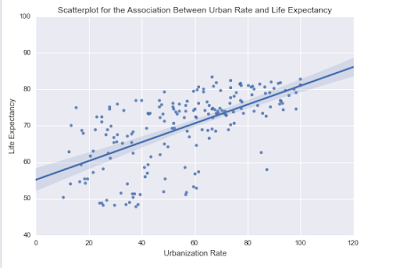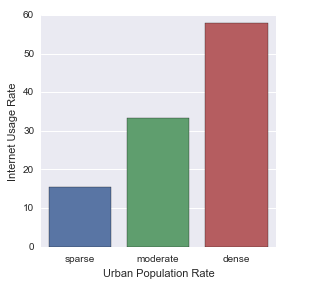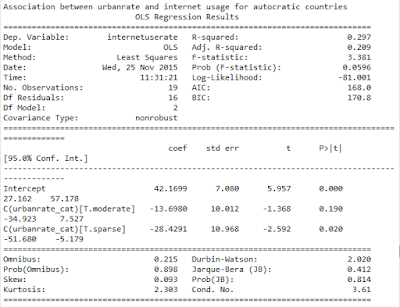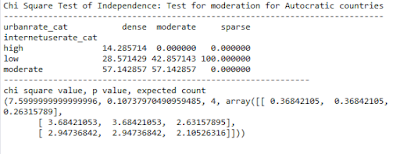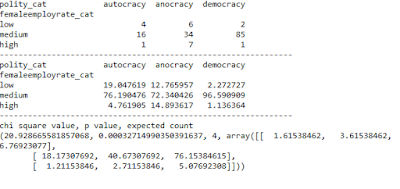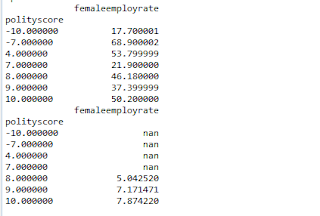HYPOTHESIS
CODE
# -*- coding: utf-8 -*-
"""
Created on Tue Dec 22 12:38:05 2015
@author: Abhishek
"""
import numpy
import pandas
import statsmodels.api as sm
import seaborn
import statsmodels.formula.api as smf
# bug fix for display formats to avoid run time errors
pandas.set_option('display.float_format', lambda x: '%f'%x)
data = pandas.read_csv('gapminder.csv', low_memory=False)
# Replace empty values with NaN
data['polityscore'] = data['polityscore'].astype(numpy.object)
data['polityscore'] = data['polityscore'].replace(' ',numpy.nan)
data['polityscore'] = data['polityscore'].replace('',numpy.nan)
data['femaleemployrate'] = data['femaleemployrate'].astype(numpy.object)
data['femaleemployrate'] = data['femaleemployrate'].replace(' ',numpy.nan)
data['femaleemployrate'] = data['femaleemployrate'].replace('',numpy.nan)
data['internetuserate'] = data['internetuserate'].astype(numpy.object)
data['internetuserate'] = data['internetuserate'].replace(' ',numpy.nan)
data['internetuserate'] = data['internetuserate'].replace('',numpy.nan)
data['armedforcesrate'] = data['armedforcesrate'].astype(numpy.object)
data['armedforcesrate'] = data['armedforcesrate'].replace(' ',numpy.nan)
data['armedforcesrate'] = data['armedforcesrate'].replace('',numpy.nan)
data['lifeexpectancy'] = data['lifeexpectancy'].astype(numpy.object)
data['lifeexpectancy'] = data['lifeexpectancy'].replace(' ',numpy.nan)
data['lifeexpectancy'] = data['lifeexpectancy'].replace('',numpy.nan)
data['employrate'] = data['employrate'].astype(numpy.object)
data['employrate'] = data['employrate'].replace(' ',numpy.nan)
data['employrate'] = data['employrate'].replace('',numpy.nan)
data['incomeperperson'] = data['incomeperperson'].astype(numpy.object)
data['incomeperperson'] = data['incomeperperson'].replace('',numpy.nan)
data['incomeperperson'] = data['incomeperperson'].replace(' ',numpy.nan)
# Response Variable
data['polityscore'] = pandas.to_numeric(data['polityscore'], errors='coerce')
# Explanatory Variables
data['incomeperperson'] = pandas.to_numeric(data['incomeperperson'], errors='coerce')
data['employrate'] = pandas.to_numeric(data['employrate'], errors='coerce')
data['femaleemployrate'] = pandas.to_numeric(data['femaleemployrate'], errors='coerce')
data['internetuserate'] = pandas.to_numeric(data['internetuserate'], errors='coerce')
data['armedforcesrate'] = pandas.to_numeric(data['armedforcesrate'], errors='coerce')
data['lifeexpectancy'] = pandas.to_numeric(data['lifeexpectancy'], errors='coerce')
sub1 = data.copy()
#%%
# Data Management: Polity Score is chosen as the response variable.
# -10 to -5: Autocratic, -5 to 5: Anocratic and 5 to 10: Democratic
# Here, Anocratic countries are coded as 0 and countries with political
# biases are coded as 1. Hence we have out bivariate response variable
def RecodePolityScore (row):
if row['polityscore']<=-5 or row['polityscore']>=5 :
return 1
elif row['polityscore']>-5 and row['polityscore']<5 data-blogger-escaped-0="" data-blogger-escaped-:="" data-blogger-escaped-and="" data-blogger-escaped-def="" data-blogger-escaped-elif="" data-blogger-escaped-femaleemployrate="" data-blogger-escaped-if="" data-blogger-escaped-numpy.nan="" data-blogger-escaped-recodefemaleemprate="" data-blogger-escaped-return="" data-blogger-escaped-row="">=65 and row['femaleemployrate'] != numpy.nan :
return 1
def RecodeInternetUseRate (row):
if row['internetuserate']<=10 and row['internetuserate'] != numpy.nan:
return 0
elif row['internetuserate']>=65 and row['internetuserate'] != numpy.nan:
return 1
def RecodeArmedForcesRate (row):
if row['armedforcesrate']<=1 and row['armedforcesrate'] != numpy.nan:
return 0
elif row['armedforcesrate']>=5 and row['armedforcesrate'] != numpy.nan:
return 1
def RecodeLifeExpectancyRate (row):
if row['lifeexpectancy']<=55 and row['lifeexpectancy'] != numpy.nan :
return 0
elif row['lifeexpectancy']>=80 and row['lifeexpectancy'] != numpy.nan :
return 1
def RecodeEmploymentRate (row):
if row['employrate']<=45 and row['employrate'] != numpy.nan :
return 0
elif row['employrate']>=75 and row['employrate'] != numpy.nan :
return 1
def RecodeIncomePerPerson (row):
if row['incomeperperson']<=250 and row['incomeperperson'] != numpy.nan :
return 0
elif row['incomeperperson']>=10000 and row['incomeperperson'] != numpy.nan :
return 1
# Check that recoding is done
sub1['polityscore'] = sub1.apply(lambda row: RecodePolityScore(row),axis=1)
chk1d = sub1['polityscore'].value_counts(sort=False, dropna=True)
print (chk1d)
sub1['femaleemployrate'] = sub1.apply(lambda row: RecodeFemaleEmpRate(row),axis=1)
chk1d = sub1['femaleemployrate'].value_counts(sort=False, dropna=True)
print (chk1d)
sub1['internetuserate'] = sub1.apply(lambda row: RecodeInternetUseRate(row),axis=1)
chk1d = sub1['internetuserate'].value_counts(sort=False, dropna=True)
print (chk1d)
sub1['armedforcesrate'] = sub1.apply(lambda row: RecodeArmedForcesRate(row),axis=1)
chk1d = sub1['armedforcesrate'].value_counts(sort=False, dropna=True)
print (chk1d)
sub1['lifeexpectancy'] = sub1.apply(lambda row: RecodeLifeExpectancyRate(row),axis=1)
chk1d = sub1['lifeexpectancy'].value_counts(sort=False, dropna=True)
print (chk1d)
sub1['employrate'] = sub1.apply(lambda row: RecodeEmploymentRate(row),axis=1)
chk1d = sub1['employrate'].value_counts(sort=False, dropna=True)
print (chk1d)
sub1['incomeperperson'] = sub1.apply(lambda row: RecodeIncomePerPerson(row),axis=1)
chk1d = sub1['incomeperperson'].value_counts(sort=False, dropna=True)
print (chk1d)
#%%
# Logistic Regression
lreg1 = smf.logit(formula = 'polityscore ~ internetuserate', data = sub1).fit()
print(lreg1.summary())
print()
# Odds Ratio
print("Odds Ratio")
print("----------")
print(numpy.exp(lreg1.params))
print()
# Confidence Interval
print("Confidence Interval")
print("-------------------")
params = lreg1.params
conf = lreg1.conf_int()
conf['OR'] = params
conf.columns = ['Lower CI', 'Upper CI', 'OR']
print(numpy.exp(conf))
#%%
# Logistic Regression - femaleemployrate as explanatory variable
lreg2 = smf.logit(formula = 'polityscore ~ femaleemployrate', data = sub1).fit()
print(lreg2.summary())
print()
# Odds Ratio
print("Odds Ratio")
print("----------")
print(numpy.exp(lreg2.params))
print()
# Confidence Interval
print("Confidence Interval")
print("-------------------")
params = lreg2.params
conf = lreg2.conf_int()
conf['OR'] = params
conf.columns = ['Lower CI', 'Upper CI', 'OR']
print(numpy.exp(conf))
#%%
# Logistic Regression - armedforcesrate as explanatory variable
lreg3 = smf.logit(formula = 'polityscore ~ armedforcesrate', data = sub1).fit()
print(lreg3.summary())
print()
# Odds Ratio
print("Odds Ratio")
print("----------")
print(numpy.exp(lreg3.params))
print()
# Confidence Interval
print("Confidence Interval")
print("-------------------")
params = lreg3.params
conf = lreg3.conf_int()
conf['OR'] = params
conf.columns = ['Lower CI', 'Upper CI', 'OR']
print(numpy.exp(conf))
#%%
# Logistic Regression - lifeexpectancy as explanatory variable
lreg4 = smf.logit(formula = 'polityscore ~ lifeexpectancy', data = sub1).fit()
print(lreg4.summary())
print()
# Odds Ratio
print("Odds Ratio")
print("----------")
print(numpy.exp(lreg4.params))
print()
# Confidence Interval
print("Confidence Interval")
print("-------------------")
params = lreg4.params
conf = lreg4.conf_int()
conf['OR'] = params
conf.columns = ['Lower CI', 'Upper CI', 'OR']
print(numpy.exp(conf))
#%%
# Logistic Regression - employrate as explanatory variable
lreg3 = smf.logit(formula = 'polityscore ~ employrate', data = sub1).fit()
print(lreg3.summary())
print()
# Odds Ratio
print("Odds Ratio")
print("----------")
print(numpy.exp(lreg3.params))
print()
# Confidence Interval
print("Confidence Interval")
print("-------------------")
params = lreg3.params
conf = lreg3.conf_int()
conf['OR'] = params
conf.columns = ['Lower CI', 'Upper CI', 'OR']
print(numpy.exp(conf))
#%%
# Logistic Regression - incomeperperson as explanatory variable
lreg3 = smf.logit(formula = 'polityscore ~ incomeperperson', data = sub1).fit()
print(lreg3.summary())
print()
# Odds Ratio
print("Odds Ratio")
print("----------")
print(numpy.exp(lreg3.params))
print()
# Confidence Interval
print("Confidence Interval")
print("-------------------")
params = lreg3.params
conf = lreg3.conf_int()
conf['OR'] = params
conf.columns = ['Lower CI', 'Upper CI', 'OR']
print(numpy.exp(conf))
#%%
# Test of Confounding - internetuserate + lifeexpectancy
lreg3 = smf.logit(formula = 'polityscore ~ lifeexpectancy + internetuserate', data = sub1).fit()
print(lreg3.summary())
print()
# Odds Ratio
print("Odds Ratio")
print("----------")
print(numpy.exp(lreg3.params))
print()
# Confidence Interval
print("Confidence Interval")
print("-------------------")
params = lreg3.params
conf = lreg3.conf_int()
conf['OR'] = params
conf.columns = ['Lower CI', 'Upper CI', 'OR']
print(numpy.exp(conf))
DATA MANAGEMENT
I am using the Gapminder data set where all fields are continuous quantitative. I had to bin the response and explanatory variable into 0 and 1.
- Since I am interested in whether a country is autocratic or democratic, polity score of a country has been re-coded as 1 if score falls between -10 to -5 and 5 to 10. Anocratic countries are neutral and their score falls between -5 to 5. They are recoded as 0
- For all explanatory variables, the 2 bins are some percentage of lowest and highest quartile.
- I have taken the liberty of assigning 0 and I appropriately looking at the span of values for each explanatory variable. More research into the context, that is how data was collected and what makes sense socially need to be looked into, to correctly bin the values of the explanatory variables
LOGISTIC REGRESSION
Explanatory Variable: Internet Use Rate
P Value: The parameter estimates from the table
above shows that the regression is significant with p value 0.005. A linear
equation will not make sense here so we move on to generating odds ratio
Odds Ratio: I can interpret the odds ratio
results as, countries with high internet use rate or greater than 65% are 19.7
times more likely have a political stand (autocratic or democratic) than
countries with less internet use rate or less than 10%
Confidence Interval: I can interpret the
confidence interval as, there is a 95% certainty that the true population odds
ratio falls between 2.46 and 157.6
Regression Analysis for all other explanatory variables
From the above results we see that income per person
or GDP per capita and life expectancy are the only 2 variables who have a
significant regression against polity score.
For Explanatory Variable: Income Per Person / GDP per capita
P Value: A p value of 0.012 indicates that the regression is significant.
Odds Ratio: An odds ratio of 20.67 can be interpreted as countries with GDP per capita greater than 10K USD are 20.67 times more likely have a political stand (autocratic or democratic) than countries with with low GDP, that is below 200 USD
Confidence Interval: The confidence interval can be interpreted as, there is a 95% certainty that the true population odds ratio falls between 2 to 218.7
For Explanatory Variable: Life Expectancy
P Value: A p value of 0.012 indicates that the regression is significant.
Odds Ratio: An odds ratio of 20.67 can be interpreted as countries with GDP per capita greater than 10K USD are 20.67 times more likely have a political stand (autocratic or democratic) than countries with with low GDP, that is below 200 USD
Confidence Interval: The confidence interval can be interpreted as, there is a 95% certainty that the true population odds ratio falls between 2 to 218.7
Test for Confounding
A logistic regression was run Internet Use Rate as explanatory variable with controlled variable Life expectancy.
The parameter values shows neither Internet Use rate nor Life expectancy is significant after controlling each in the logistic regression. In fact the relationship is non existent.






















